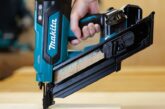
In the first of our Build it Better series with Catnic, Richard Price, Technical Director outlines how plaster bead corrosion can spoil a professional finish and how this can be avoided. Plus, read on for a chance to win some branded workwear and merchandise.
Whether it’s for a new build or a refurbishment, plastering is all about achieving a consistent and high-quality finish. One of the biggest risks to the perfect finish is corrosion of the bead under the surface, causing unsightly rust stains. In the worst cases, if left unaddressed, the corrosion can create pressure under the surface and cause the plaster to crack and crumble. However, the risk can be minimised with the correct approach.
Choosing the right product for the job
The first step is to ensure the correct bead has been selected for the application. For dry internal areas, galvanised steel plaster bead can be used. The zinc coating provides protection from atmospheric moisture, but this is not as effective as with other options. In areas exposed to a higher level of moisture, for example bathrooms and exterior applications, stainless steel or PVCu beads should be selected. These provide an improved level of resistance to corrosion. In areas with very high levels of moisture, such as in wet rooms, a PVCu bead should be considered as it is completely resistant to corrosion. For dry lining and gypsum-based plasters only galvanised and PVCu beads should be used. Therefore, the choice of beads has to be made based on the nature of the project.



Optimise drying conditions
Under normal conditions, the main risk of corrosion of galvanised beads comes with extended drying time when the bead is in contact with moist plaster. Longer drying times can occur during winter months when air temperatures are lower and moisture in the air is higher. However, drying the plaster too quickly, such as with directed heat, can cause the plaster to crack. Where possible conditions should be optimised by raising the temperature of the room, increasing airflow or reducing the humidity.
Careful handling and storage
Before installation, the beads should be stored dry off the ground, on the flat surface to prevent bending and mechanical damage.
Best practice installation
When mechanically fixing the plaster bead, it is crucial to use only corrosion-resistant fixings made of same type of metal the bead is made of. Zinc coated fixings should be used only with galvanised beads and stainless steel fixings with stainless steel beads. Where different metals are in contact in the presence of moisture, as galvanic corrosion will take place. It is going to cause surface staining and damage to the plaster.
The quality of the installation is also a factor. Firstly, it is important to only use a suitable type of plaster mix, Similarly, it is essential that only clean fresh water is used in the mix. Water contaminated with soluble salts and chlorides, in addition to weakening the plaster, can also promote metal profiles corrosion.
Care should be taken during plastering to avoid excessive trowel pressure over the beads nosing. Scratching over the nosing may result in damaging protective coating and causing rust occurrence.
Plaster bead corrosion can have a serious impact on the finish, in severe cases resulting in the need for complete replacement of rusted profiles. Minimising the risk should therefore be a priority for any professional. With the right high-quality products and best practice installation, the problem can be prevented.
To find out more about the Catnic range of plaster and render bead, visit www.catnic.com.
Competition time! Wear it Better

Each month we are giving you the chance to win a bundle of quality Catnic branded workwear and merchandise. This includes TuffStuff Elite Work Trousers, Elite body warmer and Snape Jacket as well as a Catnic Build it Better hoodie, baseball cap, beanie and golf umbrella. Ten runners up will win a Catnic hoodie.
To be in with a chance of winning, simply answer the following question:








